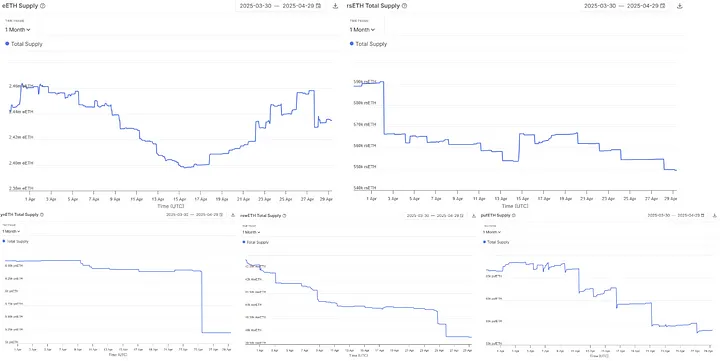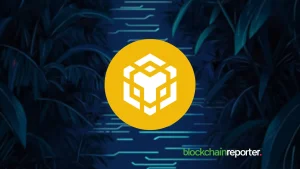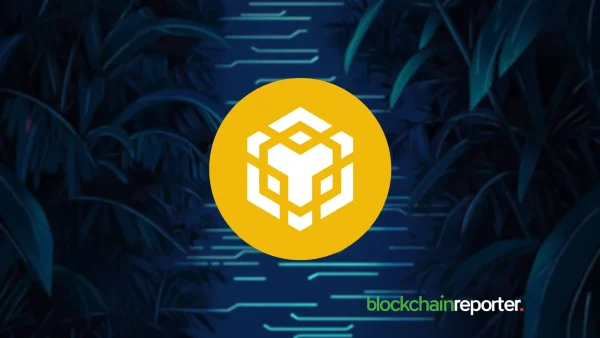
- Liquid staking token supply dropped sharply ahead of EigenLayer’s slashing activation.
- Ether.Fi dominates post-upgrade inflows while other LRTs continue to see outflows.
- $2.7B Berachain TVL unlock on May 6 may trigger volatility across EVM-based markets.
Despite gains in general crypto markets, recent DeFi trends show continued caution among investors and institutions. Data from April 2025, as reported by IntoTheBlock, shows a reduction in Ethereum staking derivatives, minimal activity in high-risk loans, and rising stablecoin minting via protocol-controlled mechanisms. A $2.7 billion total value unlock from Berachain scheduled for May 6 is expected to test liquidity conditions across EVM-compatible networks further.
Multiple liquid staking tokens (LSTs) registered large supply reductions over April. Rocket Pool’s rETH experienced the sharpest drop, falling from over 700,000 tokens to under 600,000 around April 7. sETH2 and cbETH also declined consistently, with Coinbase’s cbETH recording a steep reduction after April 10.
Wrapped Ether (wETH) decreased from approximately 2.45 million to above 2.40 million, while Lido’s stETH plateaued mid-month and then began to fall. The pufETH token remained volatile, but ultimately ended April on a downward slope.

These shifts reflect sustained outflows and unstaking across protocols. The trend aligns with user behavior ahead of EigenLayer’s activation of slashing functionality, which introduced greater risk to restaking assets. In anticipation, users withdrew tokens, reducing exposure prior to the upgrade.
EigenLayer Slashing Upgrade Alters LRT Distribution
With the successful rollout of reducing, LRT netflows have started to recover. However, inflows have concentrated heavily in Ether.Fi. While other platforms continue to experience reductions in supply, Ether.Fi has emerged as a dominant player.
Observers attribute this to the protocol’s growing liquidity depth, which appeals to large participants including institutions and whales. This asymmetric distribution highlights a shift in preference toward platforms perceived as safer or more efficient post-upgrade.
On-chain data indicates that high-risk lending positions have not grown, even as crypto asset prices recover. Loan sizes have remained stable, and liquidation activity has been relatively low for the past two weeks.
GHO Supply Reaches New Highs Through Protocol Facilitators
Aave Prime continues to record supply highs for the GHO stablecoin. This growth stems from the use of facilitator contracts, such as LidoGhoDirectMinter, which can mint unbacked GHO directly into Aave pools. The uncollateralized tokens sit in the market earning supply interest until they are borrowed.
Once a user borrows GHO, it becomes collateralized as if minted directly. Spark also implements a similar model to expand stablecoin supply while preserving internal controls. This facilitator-based strategy has enabled increased lending volumes without reliance on external liquidity providers, though it points to the need for robust monitoring mechanisms to manage systemic risk.
Berachain TVL Unlock Signals Imminent Market Volatility
From the Boyco Vaults on Berachain, there will be a release of $ 2.7 billion in total value locked on May 6. The event is expected to cause volatility not only on Berachain but also throughout the Ethereum and other EVM networks, considering it one of the biggest one-day releases in the recent history of DeFi. Such factors as slippage, APR, and strategy capacities are expected to increase in the days after the unlock due to capital allocation adjustments.
The number and the severity of the attacks on DeFi front-ends have been increasing. DNS spoofing and social engineering attacks are gradually becoming prevalent since protocols are being spread out, with third parties hosting UI copies. These attacks are very difficult to identify and defend against because they do not exploit bugs in smart contracts. People should always double check front end sources and instead opt for direct contact with the contract.









